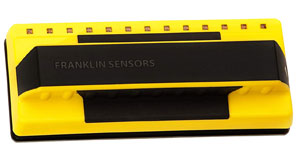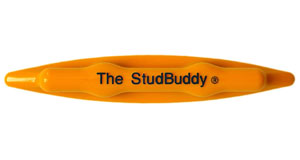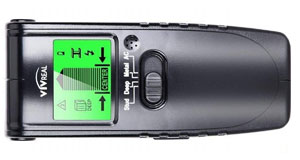7 Best Stud Finders and Wall Scanners (for Drywall, Plaster, and Tile)

Any seasoned DIYer worth his salt can testify that a good stud finder is the only difference between an instagram-able DIY home project and a glorified disaster. This is because before screwing or hammering things into walls, floors, and ceilings, you must know what exactly is on the other side.
Alternatively, you’re at the risk of damaging your drywall, ceiling, or flooring, courtesy of the unsupported items you’re attempting to install. The fundamental purpose of the best stud finder (or any stud finder) is to accurately locate the wooden framing studs behind walls (usually drywall).
While most devices offer this basic detection capability, some stud finders also locate metal beams, nails, or live electrical wires behind drywall or even plaster. You aren’t restricted to just walls though. Stud finders also work to locate joists in ceilings and some floors.
Whether you’re hanging a picture or TV on the wall, or starting a complete room renovation, a stud detector you can trust is a must.
Our 7 Favorite Stud Finders for Home or Professional Use
| Product | Type | Weight | Scan Depth | |
|---|---|---|---|---|
 | Franklin ProSensor 710 | Electronic | 9 oz | Up to 1.5" |
 | CH Hanson 03040 | Magnetic | 2 oz | Up to 1.0" |
 | StudPoP | Magnetic | 1 oz | Up to 0.5" |
 | The StudBuddy | Magnetic | 2 oz | Up to 0.5" |
 | Zircon MetalliScanner m40 | Electronic | 11 oz | Up to 4.0" |
 | Zircon StudSensor e50 | Electronic | 8 oz | Up to 1.5" |
 | Vivreal VIVSF-01 | Electronic | 5 oz | Up to 1.5" |
Stud Finder Reviews
#1 – Franklin Sensors ProSensor 710
 You know what separates the best stud finder from the rest? Its accuracy. All the other features mean practically nothing if you cannot trust the tool’s accuracy to detect.
You know what separates the best stud finder from the rest? Its accuracy. All the other features mean practically nothing if you cannot trust the tool’s accuracy to detect.
If you don’t know what you’re hammering into, you may on the verge of nothing short of a disaster. Unlike other models, Deep Scanning is always active so it’ll detect studs up to 1.5″ away
This popular stud sensor is engineered to detect a broad area of the wall while sniffing for studs underneath. Also, the additional width of the device enables you to have a more precise sense of stud positions as you propel the finder along the surface.
With 13 individual sensors, it will allow you to find and mark both edges of a stud at a glance and can even detect multiple studs at the same time. That’s simply not possible with other electronic stud detectors since they use only a single sensor.
Here’s a quick demonstration of how the sensor lights work:
With no calibration needed (unlike many other electronic models), you’re ready to go. When the edge of a stud is detected, LED lights on the front will light up, marking the position and size of any stud to allow you to find the exact starting and ending points of the stud as you work.
The Franklin Sensors model is considered one of the best wall scanners for professional contractors, homeowners, or anyone else who needs a reliable stud detector. Whether you’re installing a new HD television or upgrading your garage lights, the ProSensor is quick and accurate.
Probably its biggest downside is that while it can detect other objects behind walls such as electrical wiring, there’s no separate notification so you won’t know whether it’s a stud, live wire, or nail.
>> Check current price <<
#2 – CH Hanson 03040 Magnetic Stud Finder
 A magnetic stud finder is a throwback to the good old days. However, despite its simplicity, it’s one of the best cheap stud finders you’ll ever find. Because it doesn’t need batteries, you never have to question its accuracy.
A magnetic stud finder is a throwback to the good old days. However, despite its simplicity, it’s one of the best cheap stud finders you’ll ever find. Because it doesn’t need batteries, you never have to question its accuracy.
The device uses ultra-powerful earth magnets to locate nails and metal studs the old school way. The magnets are strong enough that the stud finder stays on the wall hands-free so you can avoid marking up the wall with a pencil.
The CH Hanson 03040 is naturally attracted to the screws and nails within the studs so you know exactly where they’re at. This mini stud finder all includes a two-way level for ease of use.
See Also: Best Tape Measures for Quick, Accurate Measuring
While there’s plenty of other magnetic stud sensors on the market, the CH Hanson is one of a few that includes two magnets for a detection area that’s almost twice as wide (at about 2.5″).
Of course this can’t compete with the 7″ wide ProSensor above but we’re talking about two completely different price points.
I might take a bit longer to find studs and the 1-inch scan depth isn’t the greatest, but for the occasional hanging of frames, pictures, and other objects onto a wall, the CH Hanson is an excellent budget pick when you simply don’t need any bells and whistles.
>> Check current price <<
#3 – StudPoP Magnetic Stud Detector
 This little stud finder uses the power of magnets to locate metal fasteners up to 1/2 inch deep within the wall. It can be used on almost any wall material effectively.
This little stud finder uses the power of magnets to locate metal fasteners up to 1/2 inch deep within the wall. It can be used on almost any wall material effectively.
The indicator visibly moves and clicks when a fastener is found, making it easier to avoid false positives. Best of all, this tool doesn’t require any form of batteries or calibration and won’t respond to active wires.
For such a simple design, there’s a lot to be said for the StudPoP. The large plastic ring means you won’t lose it like you would an individual magnet.
It’s also a lot easier to hold and move around while being just as effective (and sometimes moreso) than electronic models.
The single biggest complaint about this product is the strength of its magnet. While effective, it’s weaker than a molybdenum or neodymium magnet, limiting its effectiveness with thicker walls.
Some users have noted there’s a bit of a learning curve to this tool, but once you get the hang of it, the StudPoP can prove more effective than most electronic models. Sometimes, simple is best when you’re trying to quickly locate wall studs.
>> Check current price <<
#4 – The StudBuddy Magnetic Stud Finder
 Electronic stud finders are often complicated to use and thus prone to false readings. Like a couple other products in this list, the StudBuddy eliminates this flaw by using the power of magnets to locate fasteners embedded in studs.
Electronic stud finders are often complicated to use and thus prone to false readings. Like a couple other products in this list, the StudBuddy eliminates this flaw by using the power of magnets to locate fasteners embedded in studs.
Designed mainly for drywall use, the “made in the USA” StudBuddy is strong enough to hang on the wall where the fastener was discovered, creating an easy reference point while you dig for a drill or nail.
The elongated shape of the StudBuddy gives it better coverage than some other magnetic finders. The magnet is strong enough that you can feel a distinct pull when it approached a metal fastener.
Its ability to hang freely over a found fastener adds an extra level of convenience missing in all but a few stud finders on the market.
While the StudBuddy works well on drywall, it’s not designed for use on plaster, lath, or other wall materials, severely reducing its usefulness.
Like other magnetic stud locators, it relies on finding metal fasteners, so it can be more difficult to locate the stud location as you hunt for a drywall screw versus an electronic finder.
>> Check current price <<
#5 – Zircon MetalliScanner m40 Metal Detector
 When normal stud finders just don’t go deep enough or you need to locale nails or screws in studs or other metal behind plaster, lath, tile, concrete, paneling, stucco, or other surfaces, the MetalliScanner m40 is your best option.
When normal stud finders just don’t go deep enough or you need to locale nails or screws in studs or other metal behind plaster, lath, tile, concrete, paneling, stucco, or other surfaces, the MetalliScanner m40 is your best option.
It’s able to detect ferrous (magnetic) metal up to 4 inches deep and non-ferrous (non-magnetic) metal up to 2 inches deep.
Unless you want to spend hundreds of dollars on a professional wall scanner, this Zircon is by far the best metal stud finder for the money. Plumbers and HVAC pros can quickly locate piping and ductwork behind walls when others can’t.
On older homes with plaster or lath walls, most stud finders simply won’t work. The MetalliScanner locates studs in these walls like a champ, making it also the best stud finder for plaster walls. The auto-calibrating feature will save you some time as well.
While it won’t pick up all metal behind walls (it has a harder time with copper piping for instance) and it may miss really small nails, you really can’t get a comparable product for the price.
>> Check current price <<
#6 – Zircon StudSensor e50
 If you’re an occasional weekend project enthusiast, then the Zircon StudSensor e50 is a stud finder for when you’re on a budget but want the accuracy of an electronic model. It’s very similar to the VivReal scanner below and while it doesn’t have as many scan modes, stud detection seems more accurate.
If you’re an occasional weekend project enthusiast, then the Zircon StudSensor e50 is a stud finder for when you’re on a budget but want the accuracy of an electronic model. It’s very similar to the VivReal scanner below and while it doesn’t have as many scan modes, stud detection seems more accurate.
The stud sensor will flash and beep at once upon detecting the edge of a stud. It comes with two scanning modes: StudScan for studs up to 0.75 inch deep and DeepScan for targets around 1.5 inch deep.
For best accuracy, only use DeepScan mode if the standard mode isn’t working well.
Lastly, the product also has the capacity to detect live AC wires to prevent drilling into highly risky electrical hazards.
As one of the cheapest electronic stud sensors on the market, it’s also one of the most popular for home use. Most users say it does a fairly good job locating studs but others claim it wouldn’t detect a stud behind drywall where another model would.
If you have the budget to go with our top pick, the ProSensor 710, we feel it’s a better and more consistent option. Even the magnetic CH Hanson seems more reliable to us but we simply included this model due to its popularity.
>> Check current price <<
#7 – VivReal VIVSF-01
 The top-selling VivReal 4-in-1 multifunction wall scanner has features other electronic scanners don’t. With four switchable modes, Stud, Deep, Metal, and AC, it can detect wood, metal, and AC wires deep inside the wall to correctly locate studs and prevent hazards.
The top-selling VivReal 4-in-1 multifunction wall scanner has features other electronic scanners don’t. With four switchable modes, Stud, Deep, Metal, and AC, it can detect wood, metal, and AC wires deep inside the wall to correctly locate studs and prevent hazards.
The large graphic provides various cues for detection and even shows the current battery level. Knowing when the 9-volt battery needs replacing is important when it comes to stud detection.
A low battery level is one of the main reasons an electronic stud finder will give inconsistent results and we wonder why every electronic model doesn’t have this feature.
Normal Stud Scan mode detects the center and edges of wood or metal studs up to 3/4″ deep. Deep Scan mode detects metal like screws and nails up to 1.5″ deep. Metal Scan mode is great for locating larger metal (such as rebar) up to 2-1/4″ deep. AC mode is for locating live electrical wires up to 2″ deep.
For typical at-home use such as hanging picture frames or shelving, the VivReal stud finder is worth considering. The build quality may not be the greatest and some users question its accuracy, but as an inexpensive electronic wall scanner, it’s a good value.
>> Check current price <<
FAQs
How Do Stud Finders Work? (Magnetic vs. Electronic)
 A magnetic stud finder operates without any batteries since it uses a rare-earth magnet (or magnets). It doesn’t actually detect studs but instead locates the nails or screws attached to the wood.
A magnetic stud finder operates without any batteries since it uses a rare-earth magnet (or magnets). It doesn’t actually detect studs but instead locates the nails or screws attached to the wood.
It’s a little more time consuming to operate since you’re hunting for metal fasteners and doesn’t work so well on the walls of older buildings where a deeper scan is needed.
Conversely, an electronic stud finder includes electronic components with the ability to use actual sensors to assist you in discovering the precise location of studs.
Moreover, such electronic devices come with LED lights and audible tones to inform you the moment the edge of a stud is detected. Their biggest negative is that they require a 9-volt (or AA) battery which can provide poor results if not regularly replaced.
What does a stud finder detect?

It is used to detect framing studs placed behind the final walling surface, typically drywall. Sometimes it relies on detecting the metal in the studs to locate them. A few models are also useful on floors and ceilings.
Why are false positives fairly common when using a stud finder?
It’s usually a variety of reasons. Sometimes builders rush and studs in walls aren’t totally straight or have slightly shifted over time. Sometimes the drywall contains small bubbles which may interfere with a stud finder.
With electronic models, batteries that are almost drained can give poor results.






